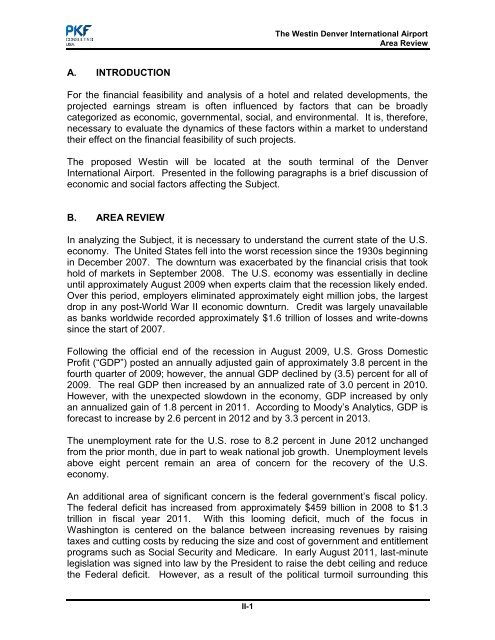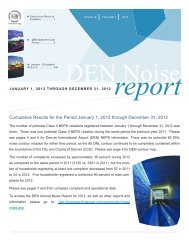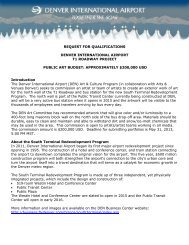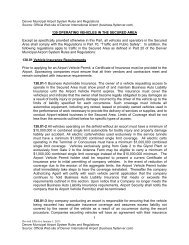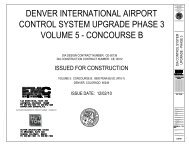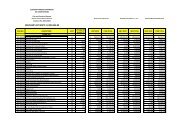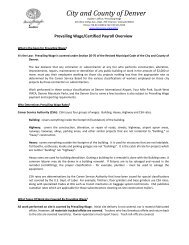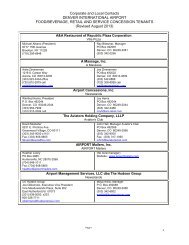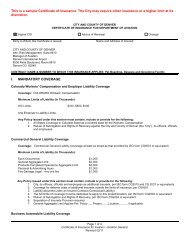PKF Hotel Market Demand and Financial Analysis - DIA Business ...
PKF Hotel Market Demand and Financial Analysis - DIA Business ...
PKF Hotel Market Demand and Financial Analysis - DIA Business ...
Create successful ePaper yourself
Turn your PDF publications into a flip-book with our unique Google optimized e-Paper software.
The Westin Denver International AirportArea ReviewA. INTRODUCTIONFor the financial feasibility <strong>and</strong> analysis of a hotel <strong>and</strong> related developments, theprojected earnings stream is often influenced by factors that can be broadlycategorized as economic, governmental, social, <strong>and</strong> environmental. It is, therefore,necessary to evaluate the dynamics of these factors within a market to underst<strong>and</strong>their effect on the financial feasibility of such projects.The proposed Westin will be located at the south terminal of the DenverInternational Airport. Presented in the following paragraphs is a brief discussion ofeconomic <strong>and</strong> social factors affecting the Subject.B. AREA REVIEWIn analyzing the Subject, it is necessary to underst<strong>and</strong> the current state of the U.S.economy. The United States fell into the worst recession since the 1930s beginningin December 2007. The downturn was exacerbated by the financial crisis that tookhold of markets in September 2008. The U.S. economy was essentially in declineuntil approximately August 2009 when experts claim that the recession likely ended.Over this period, employers eliminated approximately eight million jobs, the largestdrop in any post-World War II economic downturn. Credit was largely unavailableas banks worldwide recorded approximately $1.6 trillion of losses <strong>and</strong> write-downssince the start of 2007.Following the official end of the recession in August 2009, U.S. Gross DomesticProfit (“GDP”) posted an annually adjusted gain of approximately 3.8 percent in thefourth quarter of 2009; however, the annual GDP declined by (3.5) percent for all of2009. The real GDP then increased by an annualized rate of 3.0 percent in 2010.However, with the unexpected slowdown in the economy, GDP increased by onlyan annualized gain of 1.8 percent in 2011. According to Moody’s Analytics, GDP isforecast to increase by 2.6 percent in 2012 <strong>and</strong> by 3.3 percent in 2013.The unemployment rate for the U.S. rose to 8.2 percent in June 2012 unchangedfrom the prior month, due in part to weak national job growth. Unemployment levelsabove eight percent remain an area of concern for the recovery of the U.S.economy.An additional area of significant concern is the federal government’s fiscal policy.The federal deficit has increased from approximately $459 billion in 2008 to $1.3trillion in fiscal year 2011. With this looming deficit, much of the focus inWashington is centered on the balance between increasing revenues by raisingtaxes <strong>and</strong> cutting costs by reducing the size <strong>and</strong> cost of government <strong>and</strong> entitlementprograms such as Social Security <strong>and</strong> Medicare. In early August 2011, last-minutelegislation was signed into law by the President to raise the debt ceiling <strong>and</strong> reducethe Federal deficit. However, as a result of the political turmoil surrounding thisII-1


